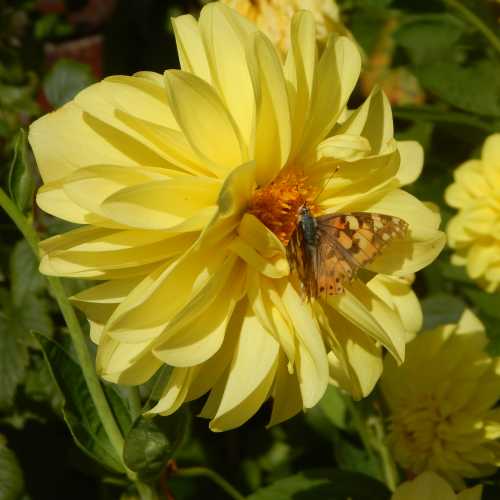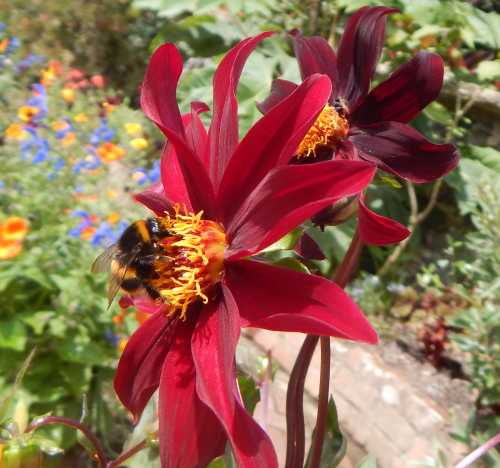Which Dahlias Do Bees Like?
Which dahlias do bees like? These lovely plants offer a variety of gorgeous blooms that are popular with bees, butterflies and other pollinators.
Gorgeous shades of red, pink, orange, yellow and white are available. Flower heads can be showy with many petals, or simple, with fewer petals.
Very often, the accepted wisdom is that simple, single-petalled, open flower heads are best for bees and butterflies, but of course, there are always exceptions. If you like showy blooms and want to help bees, you will easily find a number of dahlia varieties to fit the bill.
Which pollinators visit dahlias?
If you select the right varieties, they'll be visited by bumble bees, honey bees and various solitary bees.
 Dahlias offer a variety of gorgeous blooms that are popular with bees, butterflies and other pollinators. Here, a common carder bumble bee.
Dahlias offer a variety of gorgeous blooms that are popular with bees, butterflies and other pollinators. Here, a common carder bumble bee.Butterflies are also attracted to the flower heads, and for me, it is an especially lovely sight: gorgeous, showy blooms decorated with a beautiful butterfly!
Various flies, including hover flies also visit. They don't mind sharing the flower heads either.
 Painted Lady butterfly on dahlia.
Painted Lady butterfly on dahlia.
Which dahlia varieties do bees and pollinators like?
I couldn't possibly list all of them, but many suppliers state suitability for pollinators as appropriate, and here are a few examples:
Reds and deep crimsons:
- Dahlia 'Bishop of Llandaff'
- Dahlia 'Annika'
- Dahlia 'Bishop of Auckland'
- Dahlia 'Scarlet Fern'
- Dahlia Pulp Fiction
- Dahlia 'Dark Desire'
- Dahlia 'Mystic Wonder'
- Dahlia 'Twyning's Chocolate'
- Dahlia 'Nuit d'Eté'
- Various from the 'Figaro' collection.
 Common carder bumble bee on dahlia 'Bishop of Auckland'.
Common carder bumble bee on dahlia 'Bishop of Auckland'.Pinks:
- Dahlia 'Happy Single Wink'Dahlia 'Pretty Woman'
- Dahlia 'Star Wars'
- Dahlia 'Bishop of Leicester'
- Dahlia 'Teesbrooke Red Eye'
- Dahlia 'Hillcrest Regal'
- Dahlia 'Chatsworth Splendour'
- Dahlia 'Fascination'
- Dahlia 'Harvest Samantha'
- Dahlia 'Little Dorrit'
- Dahlia 'Tartarus'
- Dahlia 'Twyning's Pink Fish'
- Various from the 'Figaro' collection.
Oranges and yellows:
- Dahlia 'Bishop of York' (Misc)
- Dahlia 'Harvest Amanda'
- Dahlia 'Pooh - Swan Island'
- Dahlia 'Ossie Latham'
- Dahlia 'Moonfire'
- Dahlia 'Sunshine'
- Dahlia 'Harvest Inflammation'
- Dahlia 'Yellow Hammer'
- Various from the 'Figaro' collection.
 Painted lady butterfly -I believe this dahlia is from the Figaro collection.
Painted lady butterfly -I believe this dahlia is from the Figaro collection.White:
- Dahlia 'Omo'
- Dahlia 'Cherubino'
- Dahlia 'Twyning's After Eight'
- Dahlia 'Trelyn Daisy'
- Dahlia 'Classic Swanlake'
- Various from the 'Figaro' collection
Peachy shades, blushed pink/yellow/orange:
- Dahlia 'Happy Single Date'
- Dahlia 'Waltzing Mathilda'
- Dahlia 'Carol Klein'
- Dahlia 'Peachette'
- Dahlia 'John Hill'
- Dahlia 'Dream Seeker'
- Dahlia 'Bishop of Oxford'
- Dahlia 'April Heather'
- Dahlia 'Classic Poème'
- Various from the 'Figaro' collection
 Common carder bumble bee on dahlia 'Happy Single Date'.
Common carder bumble bee on dahlia 'Happy Single Date'.
How to grow dahlias
Dahlias are tubers, and need a sunny spot in well-drained, humus-rich soil. Cut them back close to the ground in autumn after flowering.
If you live in a colder climate with heavy soil, it's a good idea to go a step further: dig up the tubers in autumn, clean, dry and store them in a tray (cover them with a little potting compost). Replant them in spring the following year.
 Honey bee foraging on dahlia flower.
Honey bee foraging on dahlia flower.Alternatively, dahlias can be started off in pots under glass in early spring, then planted out when the danger of frost has passed. Ensure you plant them about 12 inches deep, and leave plenty of room between tubers to allow the plant to spread and grow.
Dahlia Flowering season
 With dahlias, you can always find something to plug a gap in your border, add vibrancy and feed the bees at the same time.
With dahlias, you can always find something to plug a gap in your border, add vibrancy and feed the bees at the same time.One of the best things about dahlias is that you can find varieties that will bloom in spring, summer or autumn. As such, you can always find something to plug a gap in your border, add vibrancy and feed the bees at the same time.
More articles about bees and plants
- Bees Foraging On Eryngium (Sea Holly) Eryngium: A magnet for bumble bees, honey bees and various solitary species. It is fairly hardy.
- Bees & Poppies Bees love foraging on poppies for pollen - especially the Opium Poppy - Papaver somniferum
- Pulmonaria Officinalis - A Wonderful Early Flowering Plant For Bees Pulmonaria Officinalis attracts bumblebees and hairy footed flower bees and is easy to grow
- Bees love lupins – but so do slugs and snails, so what can you do? Bees love lupins – but so do slugs and snails, so what can you do? Here's a way to protect your lupins....using garlic!
- Bees And Bee Balm Bee Balm (Monarda) - also known as 'Bergamot) is a herbaceous perennial which is attractive for bees.